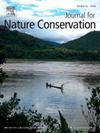中国东北湿地生态系统中濒危东方白鹳栖息地适宜性的时空分析
IF 2.2
3区 环境科学与生态学
Q2 BIODIVERSITY CONSERVATION
引用次数: 0
摘要
人类引起的栖息地改造往往会导致栖息地退化和丧失,影响濒危和珍稀物种的适宜栖息地。本研究旨在评估中国东北地区湿地生态系统中濒危物种东方白鹳的适宜栖息地,以促进物种与栖息地的成功保护。该研究结合了实地调查、文献综述、植被指数计算、用于评估猎物丰度的 eDNA 以及 2000 年、2011 年和 2022 年的土地利用和土地覆被分类。研究人员开发了基于模糊逻辑的栖息地模型,以绘制东方白鹳的适宜栖息地图。利用广义线性模型(GLM)和主成分分析(PCA)评估了各种环境变量对栖息地适宜性变化的影响。以东方白鹳的栖息地为参考点,评估环境因素对栖息地适宜性的影响。结果表明,20%的区域非常适合鹳鸟栖息,73.4%的区域适度适合,5.6%的区域不太适合或不适合。湖泊和河流附近的归一化差异植被指数(NDVI)低、归一化差异水指数(NDWI)高的栖息地比靠近道路和建筑密集区的地区更适合白鹳栖息。猎物丰度,尤其是鱼类,是决定东方白鹳出现和生存的关键因素。沼泽地、沼泽和水体被认为是最适合东方白鹳的栖息地,因为它们与湖泊生态系统相接,为东方白鹳提供了丰富的猎物。我们的发现强调了持续努力保护湿地生态系统和濒危珍稀鸟类栖息地的重要性。被确定为东方白鹳重要栖息地的栖息地应得到优先保护。本文章由计算机程序翻译,如有差异,请以英文原文为准。
Spatio-temporal analysis of habitat suitability for the endangered oriental white stork (Ciconia boyciana) in the wetland ecosystem of northeast China
Human-induced habitat transformation often leads to habitat degradation and loss, impacting suitable habitats for endangered and rare species. This study was conducted to assess suitable habitats for the endangered oriental white stork in the wetland ecosystem of northeast China, to facilitate successful species-habitat conservation. The study incorporated field surveys, literature reviews, vegetation index calculations, eDNA for assessing prey abundance and land use and land cover classification for the years 2000, 2011, and 2022. A fuzzy logic-based habitat model was developed to map suitable habitats for the oriental stork. Generalized Linear Models (GLM) and Principal Component Analysis (PCA) were used to assess the influence of various environmental variables on habitat suitability changes. Roosting locations of the oriental stork were used as reference points to evaluate the impact of environmental factors on habitat suitability. The results indicate that 20% of the area is highly suitable for the stork, 73.4% is moderately suitable, and 5.6% is less or not suitable. Habitats near lakes and rivers, with low Normalized Difference Vegetation Index (NDVI) and high Normalized Difference Water Index (NDWI), are more suitable compared to areas close to roads and built-up zones. Prey abundance, particularly fish, is a crucial determinant of oriental stork presence and survival. Marshlands, swamps, and water bodies were identified as the most suitable habitats, as they interface with lotic and lentic ecosystems providing abundant prey for the storks. Our findings emphasize the importance of ongoing efforts to protect wetland ecosystems and habitats for endangered and rare bird species. Priority should be given to habitats identified as critical roosting areas for the oriental stork.
求助全文
通过发布文献求助,成功后即可免费获取论文全文。
去求助
来源期刊

Journal for Nature Conservation
环境科学-生态学
CiteScore
3.70
自引率
5.00%
发文量
151
审稿时长
7.9 weeks
期刊介绍:
The Journal for Nature Conservation addresses concepts, methods and techniques for nature conservation. This international and interdisciplinary journal encourages collaboration between scientists and practitioners, including the integration of biodiversity issues with social and economic concepts. Therefore, conceptual, technical and methodological papers, as well as reviews, research papers, and short communications are welcomed from a wide range of disciplines, including theoretical ecology, landscape ecology, restoration ecology, ecological modelling, and others, provided that there is a clear connection and immediate relevance to nature conservation.
Manuscripts without any immediate conservation context, such as inventories, distribution modelling, genetic studies, animal behaviour, plant physiology, will not be considered for this journal; though such data may be useful for conservationists and managers in the future, this is outside of the current scope of the journal.
 求助内容:
求助内容: 应助结果提醒方式:
应助结果提醒方式:


